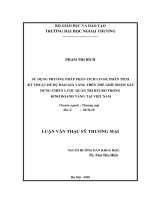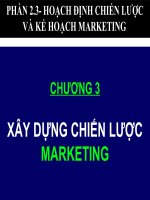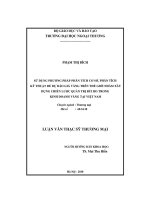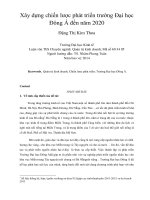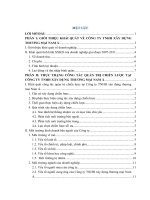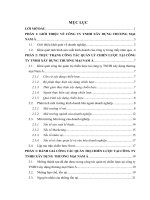Towards the formulation of a new marketing mix strategy of habeco in the new economic era = xây dựng chiến lược marketing mix tại HABECO trong thời kỳ mới
Bạn đang xem bản rút gọn của tài liệu. Xem và tải ngay bản đầy đủ của tài liệu tại đây (1.31 MB, 75 trang )
ĐẠI HỌC QUỐC GIA HÀ NỘI
KHOA QUẢN TRỊ VÀ KINH DOANH
---------------------
NGÔ VIỆT HÀ
TOWARDS THE FORMULATION
OF A NEW MARKETING MIX STRATEGY
OF HABECO IN THE NEW ECONOMIC ERA
XÂY DỰNG CHIẾN LƯỢC MARKETING MIX
TẠI HABECO TRONG THỜI KỲ MỚI
LUẬN VĂN THẠC SĨ QUẢN TRỊ KINH DOANH
Hà Nội - 2017
ĐẠI HỌC QUỐC GIA HÀ NỘI
KHOA QUẢN TRỊ VÀ KINH DOANH
---------------------
NGÔ VIỆT HÀ
TOWARDS THE FORMULATION
OF A NEW MARKETING MIX STRATEGY
OF HABECO IN THE NEW ECONOMIC ERA
XÂY DỰNG CHIẾN LƯỢC MARKETING MIX
TẠI HABECO TRONG THỜI KỲ MỚI
Chuyên ngành: Quản trị kinh doanh
Mã số: 60 34 01 02
LUẬN VĂN THẠC SĨ QUẢN TRỊ KINH DOANH
NGƯỜI HƯỚNG DẪN KHOA HỌC: TS. HOÀNG ANH TUẤN
Hà Nội - 2017
DECLARATION
The author confirms that the research outcome in the thesis is the result of
author‟s independent work during study and research period and it is not yet
published in other‟s research and article.
The other‟s research result and documentation (extraction, table, figure,
formula, and other document) used in the thesis are cited properly and the
permission (if required) is given.
The author is responsible in front of the Thesis Assessment Committee,
Hanoi School of Business, and the laws for above-mentioned declaration.
Ha Noi, 07 August 2017
Ngo Viet Ha
i
ACKNOWLEDGMENT
Writing a master thesis is a gratifying but difficult and sometimes nerve
wrecking endeavor that few engaged in because it requires a lot of sacrifices and
hard work from the researcher. However, at the end of one‟s task, one experiences a
wonderful feeling of joy, happiness, relief and fulfillment.
The researcher would like to extend her sincerest gratitude and thanks to the
following people who were very instrumental in the fulfillment of this research study.
Associate Prof. HOANG DINH PHI, Ph. D., President of Hanoi School of
Business and Management, for his untiring effort and belief that this program is
possible thus enabling us to pursue the MBA degree;
DR. HOANG ANH TUAN, Ph. D., thesis adviser, for his guidance and endless
support for the improvement of this study
To ALL THE HSB PROFESSORS, for their support and guidance extended
throughout the graduate studies in Hanoi School of business and management,
Vietnam;
HSB STAFF, for providing me the necessary research materials provided to us;
MANAGERS and EMPLOYEES of Hanoi Beer Alcohol Beverage joint stock
corporation, my Respondents, for their patience and cooperation in answering the
questionnaire and for other data given;
MY FAMILY and FRIENDS, for the love and support in one way or the other; and
TO ALL who have contributed to make this study a success.
Ngo Viet Ha
ii
TABLE OF CONTENTS
DECLARATION ......................................................................................................... i
ACKNOWLEDGMENT ............................................................................................ ii
List of figures.............................................................................................................. v
List of Tables ............................................................................................................. vi
INTRODUCTION ...................................................................................................... 1
1. Rationale ............................................................................................................. 1
2. Literature review ................................................................................................. 2
3. Aims of research ................................................................................................. 3
4. Objects of research .............................................................................................. 4
5. Scope of research ................................................................................................ 5
6. Research methodology ........................................................................................ 6
7. Thesis structure ................................................................................................... 7
CHAPTER 1. THEORETICAL BACKGROUND ON MARKETING MIX
STRATEGY ............................................................................................................... 8
1.1. Definition of terms ........................................................................................... 8
1.2. Strategic Marketing Planning Process ............................................................. 9
1.2.1. Marketing Situation Analysis .................................................................... 9
1.2.2. Marketing Strategy Design ...................................................................... 12
1.2.3. Marketing Mix Program Development .................................................... 15
1.2.4. Implementing and Managing Marketing Strategy ................................... 23
CHAPTER 2: APPLICATION OF THEORY: A CASE OF HABECO COMPANY26
2.1. Introduction of HABECO .............................................................................. 26
iii
2.2. Statement of the Problems ............................................................................. 28
2.3. Conceptual framework ................................................................................... 29
2.3.1. Research Design ...................................................................................... 31
2.3.2. Respondents of the study ......................................................................... 32
2.3.3. Sample and Sampling Techniques ........................................................... 32
2.3.4. Research Instruments ............................................................................... 33
2.3.5. Data gathering procedures ....................................................................... 34
CHAPTER 3: RESULTS AND DISCUSSIONS ..................................................... 35
3.1. Profile of the Respondents in Terms of Selected Variables .......................... 35
3.2. Respondents‟ Perception on the Marketing Mix Strategies of HABECO
Company in Hanoi City ........................................................................................ 38
3.3. Significant Difference on the Respondents‟ Perception on the Marketing Mix
of HABECO Company in Hanoi City................................................................... 44
3.4. Findings .......................................................................................................... 51
CONCLUSION, LIMITATION AND IMPLICATION .......................................... 54
1. Conclusion......................................................................................................... 54
2. Limitation .......................................................................................................... 55
3. Implication ........................................................................................................ 55
REFERENCES ......................................................................................................... 57
APPENDIX A........................................................................................................... 58
APPENDIX B ........................................................................................................... 59
iv
List of figures
Figure 1.1 Strategic marketing processes ................................................................ 11
Figure 1.2 Selecting a marketing strategy ................................................................ 14
Figure 1.3 Price determination process .................................................................... 21
Figure 2.1 Illustrates this conceptual framework .................................................... 31
v
List of Tables
Table 1: Frequency Distribution, Percentage and Rank of the Respondents‟ Profile
in Terms of Age ........................................................................................................ 35
Table 2: Frequency Distribution, Percentage and Rank of the Respondents‟ Profile
in Terms of Gender ................................................................................................... 35
Table 3: Frequency Distribution, Percentage and Rank of the Respondents‟ Profile
in Terms of Civil Status ............................................................................................ 36
Table 4: Frequency Distribution, Percentage and Rank of the Respondents‟ Profile
in Terms of Educational Attainment ........................................................................ 36
Table 5: Frequency Distribution, Percentage and Rank of the Respondents‟ Profile
in Terms of types of Respondents ............................................................................ 37
Table 6: Frequency Distribution, Percentage and Rank of the Respondents‟ Profile
in Terms of Monthly Income .................................................................................... 37
Table 7: Respondents‟ Perception on the Marketing Mix Strategies of HABECO
Company in Hanoi City In Terms Of Product ......................................................... 38
Table 8: Respondents‟ Perception on the Marketing Mix Strategies of HABECO
Company in Hanoi City In Terms Of Price .............................................................. 39
Table 9: Respondents‟ Perception on the Marketing Mix Stategies of
HABECO
Company in Hanoi City In Terms Of Place ............................................................. 41
Table 10: Respondents‟ Perception on the Marketing Mix Strategies of HABECO
Company in Hanoi City In Terms Of Promotion ..................................................... 42
Table 11: Composite table of General Weighted Mean of Respondents‟ Perception on
the Marketing Mix Strategies of HABECO Company in Hanoi City ........................... 43
Table 12: Computed F_value on One-Way ANOVA of the significant Difference
between the Respondents‟ age and their perception on the Marketing Mix Strategies
of HABECO Company in Hanoi City ...................................................................... 44
Table 13: Computed F_value on One-Way ANOVA of the significant Difference
between the Respondents‟ Gender and their perception on the Marketing Mix
Straegies of HABECO Company in Hanoi City ...................................................... 46
vi
Table 14: Computed F_value on One-Way ANOVA of the significant Difference
between the Respondents‟ Civil Status and their perception on the Marketing Mix
Strategies of HABECO Company in Hanoi City ..................................................... 47
Table 15: Computed F_value on One-Way ANOVA of the significant Difference
between the Respondents‟ Educational Attainment and their perception on the Marketing
Mix Strategies of HABECO Company in Hanoi City.................................................. 48
Table 16: Computed F_value on One-Way ANOVA of the significant Difference on
the Respondents‟ Perception on the Marketing Mix
Strategies of HABECO
Company in Hanoi City when grouped according to Customers, Retailers and
Wholesalers .............................................................................................................. 50
vii
INTRODUCTION
1. Rationale
Vietnam‟s domestic beer industry is preparing itself for fierce competition from
foreign beer companies after the signing of the Trans Pacific Partnership (TPP), a U.S.
led free trade agreement. Under the TPP, Vietnam will reduce its imported beer tax from
35 percent to zero percent.
Vietnam represents a clear market opportunity for foreign beer brands. Unlike some
of the other countries in the region, Vietnam has a strong culture of beer drinking.
According to the Vietnam Beer, Alcohol, and Beverage Association, Vietnam is one of
the region‟s largest consumers of beer, ranking behind only China and Japan. In 2015,
consumption levels reached 3.4 billion liters; a 2.5 percent increase year on year. The
beer market has seen an average growth of 10 percent per year.
With the conclusion of the Trans Pacific Partnership in sight, competition in
Vietnam‟s beer market is only expected to intensify.
To succeed in this environment, companies must consider the market trends
that will likely shape the industry over the next few years. This will help them
understand the challenges they will encounter and transform these challenges into
opportunities for process improvement, enhanced flexibility and, ultimately, greater
profit-ability. As everyone known developing effective marketing strategies for a
company is the key to success in its target market. Marketing helps companies to
maximize product sales through deployment of product policy, pricing, distribution
and promotion, to maximize the satisfaction of consumer, to maximize choice of
consumers. Marketing activities have become essential for both sellers and buyers
in all spheres of social life. When lack of understanding of the market will not have
the policy basis to access to market, to maximize sales to maximize profits, will not
even satisfy customers to the risk of losing customers and finally defeat in the
competition. This study will find out solutions to help HABECO become one of
powerful corporations, holding the leading role in the beer manufacturing industry
1
of Vietnam, to continue to have transition to meet integration requirements, to
contribute to the economy of the country.
2. Literature review
Nowadays, most of companies are increasingly embracing targeting marketing.
Target marketing helps sellers or suppliers identify marketing opportunities better.
The sellers can develop the right offer for each target market. They can adjust their
prices, distribution channels, and advertising to reach the target market effectively.
Therefore, designing the marketing strategy is very important for success. The
marketing strategy is always a determinant constituent of effective competitive
strategy. Cravens (2004) defined that marketing strategy is the analysis, strategy
development, and implementation activities in selecting market target strategies for
the product-markets in each business unit, setting market objectives, and
developing, implementing, and managing the marketing program positioning
strategies designed to meet the needs of the customers in each market target.
Because of marketing‟s boundary orientation between the organization and its
customers, channels members, and competition, it is central to the business strategy
planning process (Day, 1984). Strategic marketing provides the expertise for
environmental monitoring, for deciding what customer groups to serve, for setting
product specifications and for selecting which competitors to position against.
Link between Marketing Strategy and Corporate Strategy:
Corporate strategic planning involves the activities such as developing a
clear sense of the company‟s mission, identifying the company‟s strategic business
units, allocating resources to the various strategic business units, and expanding
present business and developing new ones to fill the strategic-planning gap. The
corporate strategy is concerned with what types of business the company as a
whole should be in and is therefore concerned with the scope. Marketing strategy,
on the other hand is part of functional strategy which emerges in each strategic
business unit as part of corporate strategy.
2
According to Guiltinan and Paul (1996), corporate strategy is type of plan
which outlines how a firm should use its resources to produce and market a specific
array of products and services in order to achieve overall corporate objectives. In
essence, the corporate strategy provided a general statement. It defined the products
in which the organization would be involved but left open the details of how each
product or product line would be marketed.
While the corporate strategy presents a plan developed by top management
to guide the total organization, a marketing strategy is usually developed by a
middle manager to guide a firm‟s activities for a product or a line of related
products. More specially, a marketing strategy is a plan which indicates how a
manager deploys marketing resources on an individual product or product line in
order to achieve a specified product objective (such as market-share growth or
maximizing cash flow).
3. Aims of research
Hanoi Beer Alcohol Beverage Joint stock Corporation (HABECO) was
established from Hanoi Beer Alcohol Beverage Corporation by equitization in 2007.
With unique technological know-how and hundreds years of tradition, with modern
systems and equipment, with skilled qualified dedicated staff team, the
Corporation's products have received the admiration of the million consumers in the
domestic and international. Today Hanoi Beer brands are resulted from several
generations, as consumer confidence, the pride of Vietnamese brand.
Currently, together with rising living standard, demand for beer quickly
increases and high quality brands are much preferred. More and more foreign
breweries entered the Vietnam market as well as breweries in the country made to
diversify products. Currently almost all provinces have brewery named localities,
each plant there many beers with different names and directions to the different
customers. At present, all players are facing the fierce competition between local
and foreign brands. Most of the producers try to exploit their distinctive
competencies to gain competitive advantages and select the appropriate competitive
3
strategies. They face the need of designing marketing strategies in order to attract
the consumers to buy their products.
In this situation, HABECO recognizes that development of effective marketing
strategies have to be considered as a priority in order to protect its leading position
in northern provinces and was second on the nationwide market. Through
developing marketing strategies help the company to identify its target markets,
position its products in the consumer‟s mind and develop marketing mix strategies
in order to achieve its marketing objectives and meet consumer needs and wants in
a better way than its competitors. But how can the company develop such a
marketing strategy, identify the target market or proper niches for its products, and
consolidate its position in the target market? Regarding the case of HABECO, at
present, HABECO is a leading brand of Vietnam and is facing the intensified
competition from Saigon beer, the local brewery and foreign brewery produced in
Vietnam as Heineken, Tiger… the question is:
How can HABECO protect its position in market of Hanoi city?
How can HABECO develop effective marketing strategies to increase market
share in Hanoi and surrounding areas?
To answer this question, HABECO needs to develop the marketing mix
program for each local market to defend its current market share. This research
study examines to develop the effective marketing mix strategies for HABECO in
Hanoi city in order to increase the market share, and protect its leading position in
the Hanoi beer market.
4. Objects of research
As everyone known developing effective marketing strategies for a company
is the key to success in its target market. Marketing helps companies to maximize
product sales through deployment of product policy, pricing, distribution and
promotion, to maximize satisfaction of consumer, to maximize choice of
consumers. Marketing activities have become essential for both sellers and buyers
in all spheres of social life. When lack of understanding of the market will not have
4
the policy basis to access to market, to maximize sales to maximize profits, will not
even satisfy customers to the risk of losing customers and finally defeat in the
competition. This study will find out solutions to help HABECO become one of
powerful corporations, holding the leading role in the beer manufacturing industry
of Vietnam, to continue to have transition to meet integration requirements, to
contribute to the economy of the country.
This research is the basis data to advise the Board of management of
HABECO some information to build overall development strategy of corporation. It
also enables the Executive Board have new information to offer appropriate
solutions to develop Hanoi beer brands which is popular increasingly not only on
domestically but also on the international.
Specifically, this study has very practical significance for seller and marketing
team to have conceived more than fully about the domestic market. They know that
competition is present and they have to give the specific solutions to promote to
expand market share and maintain high position of HABECO in the beer industry of
Vietnam.
This research is presented in the form of a case study exposing the complexities
of a real business environment in the beer market of Hanoi city. The purpose of this
research is to develop marketing mix strategies for HABECO in Hanoi. Thus, it is
necessary to the analyze products, price, place, promotion and current marketing
strategy of HABECO in order to formulate the marketing mix strategy.
The company mission sets out the reason why the company exits and what it
should be doing and the company‟s marketing objectives give a guideline of what it
wants to gain and become. This will serve as a guide for the process of Strategic
Marketing Mix for HABECO.
5. Scope of research
This research study was conducted at HABECO. The study has been undertaken
purely from a viewpoint of marketing relating to develop the marketing mix
strategies for HABECO in Hanoi city.
5
This research focus on respondent satisfaction relates to the development of the
marketing mix strategies including product, price, distribution, and promotion.
Data will be collected just in Hanoi city for the last 2 years. Data will be
collected by quantitative and qualitative research by depth interviews and by survey
attitudes of consumer by the structure question. So the solutions give in this thesis
has affected to market in Hanoi.
6. Research methodology
The research design for this study is the descriptive method. This will describe
the perceptions of customer who are respondents about products, price, place,
promotion of HABECO.
Data and information needed for conducting the research were obtained by
quantitative research and qualitative research. The qualitative research used here
was in-depth interviews. The quantitative research with the structure questions was
used to conduct the survey on attitude of the consumers toward beer. These
questions focused on products, prices, distribution and promotion of beer brands. It
was used for determining the design improvement of the Marketing mix strategies
for HABECO period 2016 - 2020.
The sampling size of 119 consumer respondents was chosen at random by
visiting big-size beer shops and restaurants which have logo of Hanoi beer in the
front of the shops.
The researcher used the questionnaire. It was distributed to the different respondents.
The purpose of questionnaire is to collect data regarding awareness and attitude of
customers. This process measured whether respondents are aware of the strategies,
perception of the customer on how satisfied they are and Problems and limitation of
HABECO under study as to product (Services), price, promotion, place (Distribution).
The purposes of the interviews are to have an insight into the practice of
marketing activities of HABECO, to indicate the problems and limitations of their
marketing activities and to understand and clarify management's views on the issue.
6
Written request for interview was sent to clients in advance in order to ensure
their cooperation and their active contribution.
7. Thesis structure
CHAPTER I. THEORETICAL BACKGROUND ON MARKETING MIX
STRATEGY
Background of the Study
Statement of the Problems
Conceptual Framework
CHAPTER II: APPLICATION OF THEORY: A CASE OF HABECO COMPANY
Introduction of HABECO
Research design
Respondents of the study
Sample and sampling techniques
Research instruments
Data gathering procedures
Primary data collection
Secondary data collection
Procedures in data collections
CHAPTER III: RESULTS AND DISCUSSIONS
Profile of the Respondents in Terms of Selected Variables
Respondents‟ Perception on the Marketing Mix Strategies of HABECO
Company in Hanoi City in terms of 4Ps
Significant Difference on the Respondents‟ Perception on the Marketing Mix
of HABECO Company in Hanoi City
Results: A new marketing mix strategy
CONCLUSION, LIMITATION AND IMPLICATION
7
CHAPTER 1. THEORETICAL BACKGROUND ON MARKETING MIX
STRATEGY
1.1. Definition of terms
Customers include retailers, wholesalers and consumers of the Company.
Marketing is an organizational function and a set of processes for creating,
communicating, and delivering value to customers and for managing customer
relationships in ways that benefit HABECO Company and its stake holders.
Marketing mix is a collection of mix-oriented marketing variables can be
controlled by the Company may select and use appropriate, assist each other in
order to locate a product on the market objectives identified to achieve competitive
advantage, reinforce strong position in the marketplace of the company. This study
will collect four P: Product, Price, Place, Promotion. These are tools you can use to
pursue your goals in your target market.
Market segmentation of HABECO Company is distinct groups of buyers who
might merit separate products and/or marketing mixes. The marketer tries different
variables to see which reveal the best segmentation opportunities. For each segment,
a customer-segment profile is developed. The effectiveness of segmentation
analysis depends on arriving at segments that are measurable, substantial, accessible
and actionable.
Place decides where the product is to be sold. HABECO uses the traditional
way for selling its products to wholesalers who will then sell beer product on to
retail outlets.
Price is the quantity of payment or compensation for beer products of
HABECO.
Product is fresh beer, beer Hanoi can, beer Hanoi bottle and beer Truc Bach.
Promotion is concerned with any vehicle HABECO employ for getting people
to know more about beer products and related services. Advertising, public
8
relations, point – of – sale displays, and word – of mouth promotion, internet are
ways of HABECO for promoting its products.
Strategic marketing is a market-driven process of strategy development,
taking account a constantly changing business environment and the need to achieve
high levels of customer satisfaction. Thus, marketing strategy builds competitive
advantage by combining the customer influencing strategies of the HABECO
Company into integrated array of market-focused actions. Strategic marketing links
the Company with the environment and views marketing as a responsibility of the
entire business rather than a specialized function.
1.2. Strategic Marketing Planning Process
Various steps in designing strategic marketing planning within an industry
can be found in literature and basically there principles are all similar. An approach
for strategic marketing process consist of marketing situation analysis, designing
marketing strategy, marketing program development, and implementing and
managing marketing strategy. It is shown in Figure 2.1. So there is a need to discuss
this in more detail.
1.2.1. Marketing Situation Analysis
The marketing situation analysis is the first step in the design of new strategy
or examining an existing strategy. It comprises the external and internal
environment analysis. These analyses guide the choice of marketing strategies.
The marketing environment is a place where the company must start its
search for opportunities and possible threats. It consists of all the actors and forces
that affect the company‟s ability to transact effectively with its target market. The
external
environment
can
be
divided
into
macro
environment
and
microenvironment.
The macro environment includes more general forces which often do
influence the long run activities of the company. It consists of economic, sociocultural, technological, political, legal forces in relation to the firm's total
environment. Thus, the achievements, difficulties and challenges of Vietnamese
9
economy and governmental policies will influence the development of the beer
industry.
The microenvironment includes the factors in the company‟s immediate
environment that affect its ability to serve its markets especially, the company itself,
suppliers, market intermediaries, consumers, competitors and public. One key
aspect of external analysis is evaluation of competitors' strategies, strengths and
weaknesses. Competitor analysis includes defining competitive arena, analyzing the
strategic group and describing and evaluating each key competitor in terms of
strengths and weaknesses. At present, the Vietnamese beer market becomes fiercely
competitive. So the analysis of production, consumption and competition are
necessary to identify opportunities and threats for the company.
10
Market Situation
Analysis
Analyzing markets
Market segmentation
Analyzing competition
Marketing information
Systems and research
Implementing and
Designing
Managing
Marketing Strategy
Marketing Strategy
Designing effective
Organizations
Marketing strategy
Implementation
Market targeting
Positioning strategy
Marketing strategies
For selected situations
Planning for new products
And control
Marketing Program
Development
Product portfolio strategy
Pricing strategy
Distribution strategy
Promotion strategy
Figure 1.1 Strategic marketing processes
Source: Cravens, 1994
The internal environment analysis is to help the company recognizing itself
in terms of strengths and weaknesses. The internal analysis includes the
corporation's structure, resources, production and business and marketing activities.
Corporation resources are the assets that include people, managerial skills, financial
11
circumstances, facilities, information technology and the skills and abilities within
functional areas.
In general, the situation analysis identifies opportunities and threats in the
business environment and the organization‟s strengths and weaknesses. This information
helps companies deciding how, when and where to compete in a given environment.
1.2.2. Marketing Strategy Design
Designing marketing strategy includes market segmentation and targeting,
positioning strategy and the marketing strategy choice.
Market segmentation and targeting
After evaluating market segmentation, the companies have to target the best
market segment(s). Market targeting selects the people or organizations that
company wishes to sever in the product-market. To do this, it must first evaluate
profit potential of each segment, which is a function of segment size and growth,
segment structural attractiveness, and company objectives and resources. Then,
company must decide how many segments to cover. It can ignore segment
differences (undifferentiated marketing), develop different market offers for several
segments (Differentiated marketing) or go after one or a few market segment
(concentrated marketing).
Thus, once the company‟s product-markets are identified and their relative
importance to the firm determined, it selects the targeting strategy. This decision is
the focal point of marketing strategy, since targeting guides the setting of objectives
and developing a positioning strategy.
Positioning strategy
Regardless of the types of market coverage chosen, the company must
develop and communicate for every market selected. A positioning strategy that
will clearly differentiate it or its products from competitors. Positioning is the act of
designing the company‟s offer so that it occupies a distinct and valued place in the
target customers‟ minds (Kotler, 1991).
12
Positioning strategy should take into account:
The criteria or benefits the buyer considers when purchasing a product,
including the relative importance of the criteria.
How the firm is differentiated from its competition.
The limitations of competing products regarding important buyer needs and wants.
The positioning strategy indicates how the firm or its brands would like to be
perceived in the eyes and minds of the market target customers. Therefore,
decisions about products, distribution channels, price, and promotion should create
a cohesive marketing program aimed at meeting the needs and wants of consumers
in the firm‟s target market. The marketing program combines the firm‟s marketing
capabilities into a package of actions intended to position the firm against its
competitors.
Marketing strategy selection
Selecting a marketing strategy takes into account the factors such as the rate
of growth of product-market, the diversity in the needs and wants of buyers, the
structure of competition, the organization‟s competitive advantage in which an
organization encounters. Strategy selection may involve the developing a new
marketing strategy or changing an existing strategy.
As argued by Guiltinan and Paul (1991), to choose the best marketing strategy, a
manager must consider several kinds of information, as follows (Figure 2.2).
Product objectives to help company determine the necessary basic type of
strategy. For example, if market share objectives are important, managers will
employ selective demand strategies to retain or expand market share.
Alternatively, the greater the importance of cash flow and profitability
objectives, the more likely a manager will be to select retention strategies and
strategies for increasing repurchase rates. That is, these strategies will, in
general, be less cost than acquisition strategies or strategies aimed at increasing
the number of users.
13
Nature and size of the market opportunity should be clearly established based
on the market analysis and market measurements.
Managers must have a sense of the success requirements in terms of the kinds
of competitive advantages necessary and the level of marketing expenditures
that will be necessary to meet profitability goals.
Corporate Marketing
Planning
Product Objectives
Market
Analysis
Needs of
Target
Markets
Market
Measurement
Profitability and
Productivity
Analysis
Competitive
Analysis
Marketing
Budgets
Required
Competitive
Advantages
Size of Market
Opportunity
Market
Opportunity
Market Success
Requirements
Marketing Strategy
Figure 1.2 Selecting a marketing strategy
Source: Guilinan and Paul, 1991
14
Other selections of marketing strategy include entry strategy into new
market, strategies for growth, mature and declining markets and global strategies.
Concerning with this research study, HABECO needs to develop a marketing
strategy to protect its leading position in the beer market in Hanoi city and
surrounding areas. A marketing strategy for market leader faces three challenges:
expanding the total market, protecting the market share and expanding market
share. The market leader is interested in expanding total market because it is the
main beneficiary of any increased sale. To expend the market size, the leader will
have to look for new users, new uses or more usage. To protect its existing market
share, the market leader has several defense methods: position defense, flanking
defense, preemptive defense, counter offensive defense, mobile defense or
contraction defense. The most sophisticated leaders cover themselves by doing
everything right, leaving no openings for competitive attack. Leaders can also try to
increase their market share. This makes sense if profitability increases at higher
market share levels and the company‟s tactics do not invite antitrust action.
1.2.3. Marketing Mix Program Development
Market targeting and program positioning strategies for new and existing
products guide designing strategies for each part of the marketing mix. Developing
marketing mix strategies for products, distribution, price and promotion is to
implement the positioning strategy selected and in order to achieve a coordinated
combination of its components that will accomplish the market target objectives in a
cost-effective manner.
Product strategy
Product is the first and most important element of the marketing mix. The
product strategy calls for making coordinated decisions on product mixes, product
lines, brands, packaging and labeling.
A product mix (also called product assortment) is the set of all product lines and
items that a particular seller offers for sale to buyers (Kotler, 1991). The
product mix can be describes as having a certain range (how many different
15
product lines the company carries), length (total number of items in its product
mix), depth (how many variants are offered of each product in the line) and
consistency (how closely related the various product lines are in end use,
production requirements, distribution channels or some other way).
A product line is a group of products that are closely related because they
perform a similar function are sold to the same customer groups, are marketed
through the same channels or make up a particular price range. Each product
line is usually managed by a different executive. The product line manager
should study the sales and profit contributions of each product item as well as
the way the items are positioned against competitors „items. This provides
information needed for making product line decision such as line stretching,
line filling, line modernization, line featuring and line pruning.
Developing brand policies for individual product items in line.
Packing and labeling decisions to protect, economy, convenience and promotion.
To select a product strategy, the company needs the following information
on current and anticipated performance of the products in the business unit:
Consumer evaluation of the company‟s products, particularly their strengths and
weaknesses and competition (that is, positioning by market segment information)
“Objective” information on actual and anticipated product performance on
relevant criteria such as sales, profits and market share.
This information helps management formulate strategies for each product in
the mix or line. The product strategy includes:
Developing plans for new products, this process consists of eight stages: idea
generation, idea screening, concept development and testing, marketing strategy
development, business analysis, product development, market testing and
commercialization.
Managing programs for successful products, and
16



